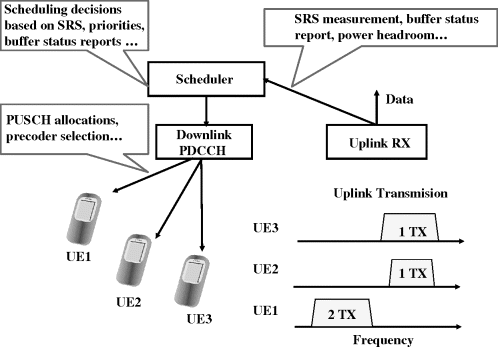7.3 Protocol Impacts from Uplink MIMO
Similar to the downlink MIMO, the uplink MIMO operation mostly impacts the physical layer. However, uplink MIMO impacts also on the other layers. The uplink MAC layer scheduler in the eNodeB needs to consider the UEs MIMO capability when making scheduling decisions. Similarly, if there is a desire to use the Virtual MIMO (MU-MIMO) feature in the uplink, the scheduler needs to consider which users can be paired together. The requirements for the pairing are now relaxed compared to Release 8 thanks to the more flexible reference signal allocation, enabling different users to overlap only partly in frequency as is addressed in Section 7.4 in more detail. MAC layer operation in connection with uplink MIMO is illustrated in Figure 7.3.
Figure 7.3 Uplink MIMO operation with eNodeB scheduler.

The RRC signalling is used to configure the parameters related to uplink MIMO. In Release 10, multi-antenna transmission is configured separately for PUSCH, PUCCH and SRS. RRC signalling is used also for enabling the uplink reference signals enhancements as covered in Section 7.4 as well as for the configuration of both periodic and aperiodic SRS for the UE.
Get LTE Advanced: 3GPP Solution for IMT-Advanced now with the O’Reilly learning platform.
O’Reilly members experience books, live events, courses curated by job role, and more from O’Reilly and nearly 200 top publishers.

